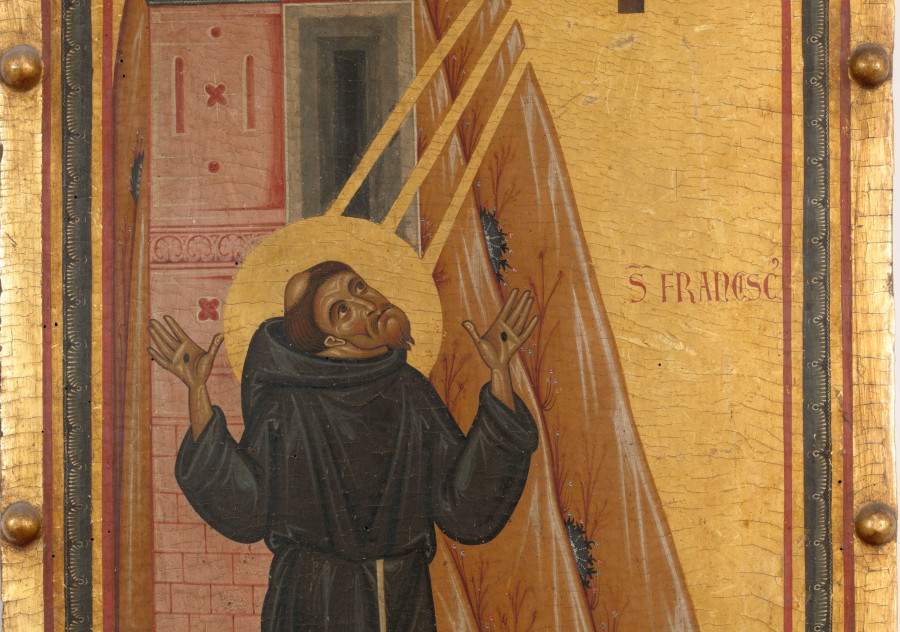Uffizi spread: one of the most valuable works dedicated to St. Francis on display in Assisi
For the first time, the work attributed to Master of the Cross No. 434 depicting St. Francis Receives the Stigmata from the Uffizi Galleries is on display in Assisi, on the occasion of the exhibition inTORNO a Francesco, curated by Giulio Proietti Bocchini and Stefano Brufani, set up in the former Pinacoteca Hall in Piazza del Comune and open until January 6, 2022. The initiative is part of the Uffizi diffusi project, thanks to the collaboration between the Uffizi and the City of Assisi, and is intended as a tribute to the Seraphic City in the 2021 Franciscan celebrations.
It is one of the most precious works in the Uffizi’s Franciscan figurative repertoire, rarely lent to other museum institutions: it is a tempera and gold dated between 1240 and 1250 in the Byzantine style that predates the Giottesque age.
The exhibition proposes a descending chronological narrative of a selection of the main works present in Assisi that depict in particular the theme of stigmatization, as well as Franciscan works of reference by style and art-historical matrix: in fact, the work leads to an in-depth study of the stigmatization of St. Francis.
The selected works are on display through photographic reproductions alternating with texts extracted from Franciscan sources to create an iconographic and narrative itinerary that culminates with the work of the Master of the Cross from the Uffizi Galleries. These include the Stained Glass Window with the Stigmata of St. Francis from the Shrine of Santa Maria at Rivotorto commissioned from Father Alberto Farina, Friedrich Overbeck’s Pardon of Assisi from the Basilica of Santa Maria degli Angeli, Dono Doni’s Stigmata of St. Francis from the Pinacoteca Comunale in Assisi, Pietro Lorenzetti’s Stigmata of St. Francis in the Lower Basilica of St. Francis, and many others.
The Uffizi panel represents one of the finest and earliest depictions of the episode of the stigmatization of St. Francis on the sacred mountain of La Verna, through which the saint of Assisi poses himself as alter Christus, distinguishing his path of faith from that of the other saints who had lived until then.
Having survived the 1266 order issued by Franciscan dignitaries meeting in Paris to destroy the figurative representations of Francis produced up to that time, the work depicts Christ crucified, high above among six blue and red wings of seraphim and cherubim, appearing to Francis in prayer.The intimate and spiritual style of the Byzantine matrix, while favoring frontal perspective and two-dimensional schematization of forms, presents new, more realistic and refined features, starting with the space, which is better defined thanks to the clear demarcation of the rocky borders of the promontory from the gold background, as well as by the presence of vegetal elements emerging from the rock, to the accurate rendering of the saint’s robe.Its original location still remains unknown, which, according to scholars, was not meant to be part of the valva of a diptych, but to be conceived as an autonomous votive image, representing even in format a product of rare value.
Hours: Daily from 10 a.m. to 1 p.m. and 2 to 6 p.m. Closed on Tuesdays.
With the exhibition ticket you are entitled to admission to the Picture Gallery, at no additional cost.
Image: Master of the Cross, Saint Francis Receives the Stigmata, detail (1240-1250; tempera and gold, Florence, Uffizi Galleries)
 |
| Uffizi spread: one of the most valuable works dedicated to St. Francis on display in Assisi |
Warning: the translation into English of the original Italian article was created using automatic tools. We undertake to review all articles, but we do not guarantee the total absence of inaccuracies in the translation due to the program. You can find the original by clicking on the ITA button. If you find any mistake,please contact us.




























